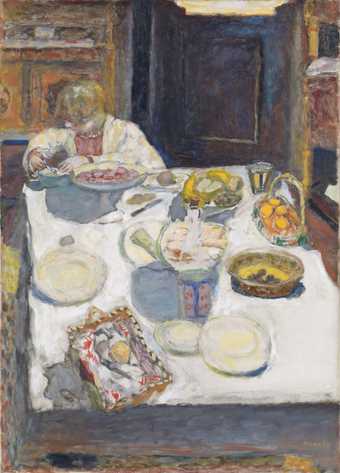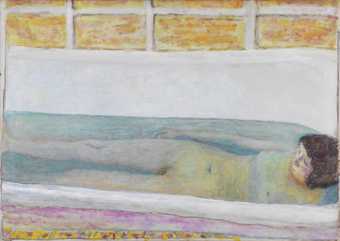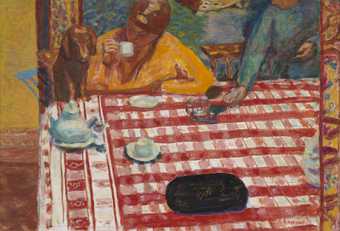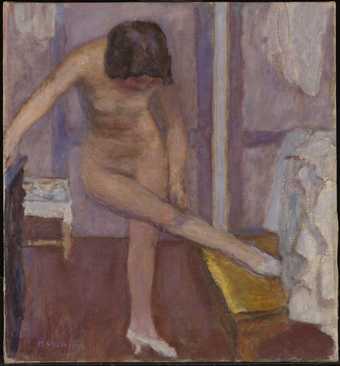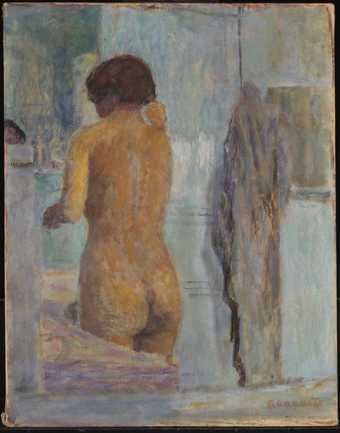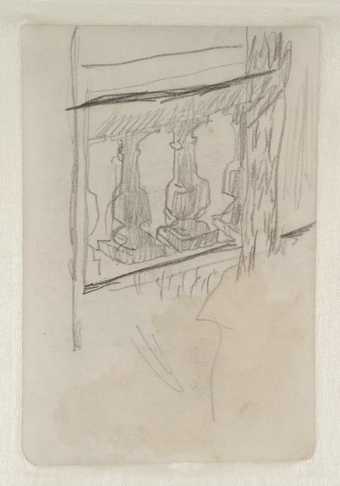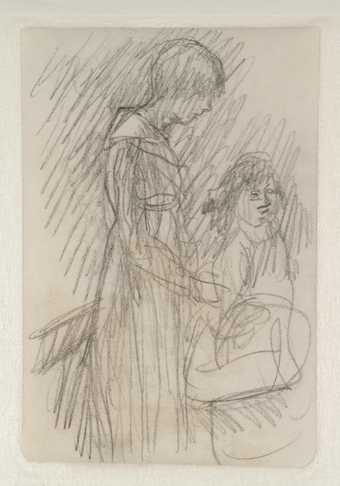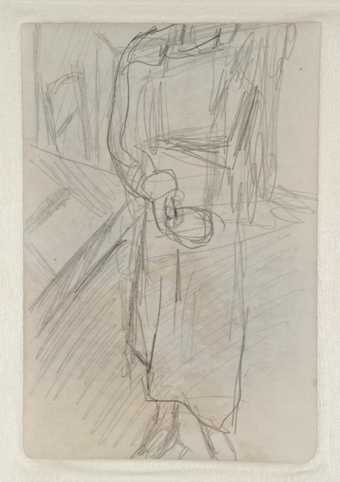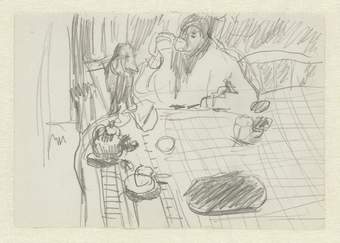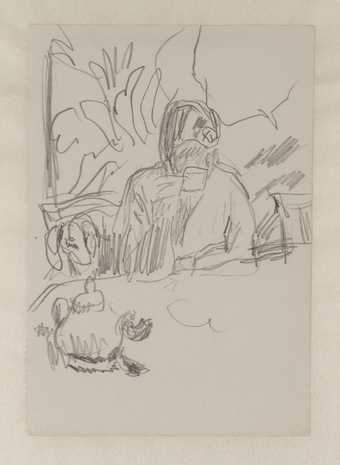
Not on display
- Artist
- Pierre Bonnard 1867–1947
- Original title
- Nu dans la baignoire
- Medium
- Oil paint on canvas
- Dimensions
- Support: 1048 × 654 × 20 mm
frame: 1237 × 852 × 76 mm - Collection
- Tate
- Acquisition
- Bequeathed by Simon Sainsbury 2006, accessioned 2008
- Reference
- T12611
Summary
This painting shows a partial view of a female figure lying a bath in a brightly lit bathroom. The composition’s extreme cropping of the bath and the scene’s dynamic vertical format produce an unusual view of the nude figure. The woman’s body is cut off along the lower edge of the canvas so that only her lower torso, left hand and legs are visible. The gleaming white rim of the tub creates a strong vertical line that divides the canvas almost into two halves. Pronounced lines in a vividly coloured and patterned rug that lies next to the bath echo those produced by the edges of the bath and the edges of the canvas and emphasise the narrowness of the space depicted. At the far left of the composition appears the partial outline of a standing figure dressed in a pale-coloured robe. This upright figure, seen in profile and cropped below the neck by the upper edge of the canvas, seems to be a man and may be the artist himself.
Bonnard’s model for Nude in the Bath was Marthe de Méligny, formerly Maria Boursin (1869–1942), who was the artist’s companion from 1893 until her death. The couple married in 1925, the year from which this painting dates. Bonnard painted Marthe over 300 times during the course of his career, and many of these images show her preparing for, immersed in, or emerging from the bath (see, for example, Bathing Woman, Seen from the Back c.1919, Tate T01077, and Nude Bending Down 1923, Tate T01076). The motif of the bathing woman can be understood not only in terms of the artist’s fascination with Marthe as a subject, but in the context of her health, as she took frequent baths as part of the treatment for a tubercular condition.
Nude in the Bath
displays Bonnard’s typically rich chromatic range. The bather’s pink flesh, the second figure’s pale blue-grey robe, and the pearly lip and interior of the enamelled bath are tinged with lilac. In contrast, the yellow, red and green floral and geometric design on the rug provides a concentration of more vibrant colours in the foreground. Bonnard emphasised flatness in this zone, which is depicted as if from an elevated viewpoint. He combined this with a perspectival view of the background, in which an area of vivid blue – perhaps a towel or garment heaped on a low table – reinforces the sense of the room’s depth.
Bonnard’s cropping of figures and his device of arranging his compositions with the main incidents occurring at the edges of the canvas, evident in Nude in the Bath, can increase the intimacy of the scene depicted while creating an atmosphere of surreptitious looking. The view of the model from above, which Bonnard also used in The Bath (Tate N04495) dating from the same year, has an eerie quality, as the bathtub, with the truncated and passive female body within it, evokes a tomb. The artist kept this painting until his death in a case with other works, including The Yellow Boat (Tate T12612).
Further reading:
Bonnard, exhibition catalogue, Tate Gallery, London 1998, reproduced p.202.
Bonnard: The Work of Art: Suspending Time, exhibition catalogue, Musée d’Art Moderne de la Ville de Paris, 2006, reproduced p.221 no.72.
Andrew Wilson (ed.), The Simon Sainsbury Bequest to Tate and the National Gallery, London 2008, reproduced p.69.
Alice Sanger
September 2010
Does this text contain inaccurate information or language that you feel we should improve or change? We would like to hear from you.
Display caption
By cropping the figures in his paintings and arranging compositions with the main incidents occurring at the edges of the canvas, Bonnard increases a sense of intimacy while also creating an atmosphere of surreptitious looking. This view of an upside-down bather seen from above is one of his most unusual and innovative compositions. The nude is identifiable as Marthe (Maria Boursin), the painter’s companion, and the second figure entering from the left as Bonnard himself. Marthe’s habit of treating her chronic throat infection with frequent baths was a recurring subject in Bonnard’s work.
Gallery label, December 2011
Does this text contain inaccurate information or language that you feel we should improve or change? We would like to hear from you.
Explore
- furnishings(3,081)
- actions: postures and motions(9,111)
-
- reclining(814)
- washing / drying(101)
- woman(9,110)
- leg(337)
- female(1,681)
You might like
-
Pierre Bonnard The Table
1925 -
Pierre Bonnard The Window
1925 -
Pierre Bonnard The Bath
1925 -
Pierre Bonnard Coffee
1915 -
Pierre Bonnard Pont de la Concorde
1913–15 -
Pierre Bonnard The Bowl of Milk
c.1919 -
Pierre Bonnard Nude Bending Down
1923 -
Pierre Bonnard Bathing Woman, Seen from the Back
c.1919 -
Pierre Bonnard Preparatory Sketch for ‘The Bowl of Milk’
c.1919 -
Pierre Bonnard Preparatory Sketch for ‘The Bowl of Milk’
c.1919 -
Pierre Bonnard Preparatory Sketch for ‘The Bowl of Milk’
c.1919 -
Pierre Bonnard Preparatory Sketch for ‘The Bowl of Milk’
c.1919 -
Pierre Bonnard Preparatory Sketch for ‘Coffee’
1915 -
Pierre Bonnard Preparatory Sketch for ‘Coffee’
1915 -
Pierre Bonnard The Yellow Boat
c.1936–8

